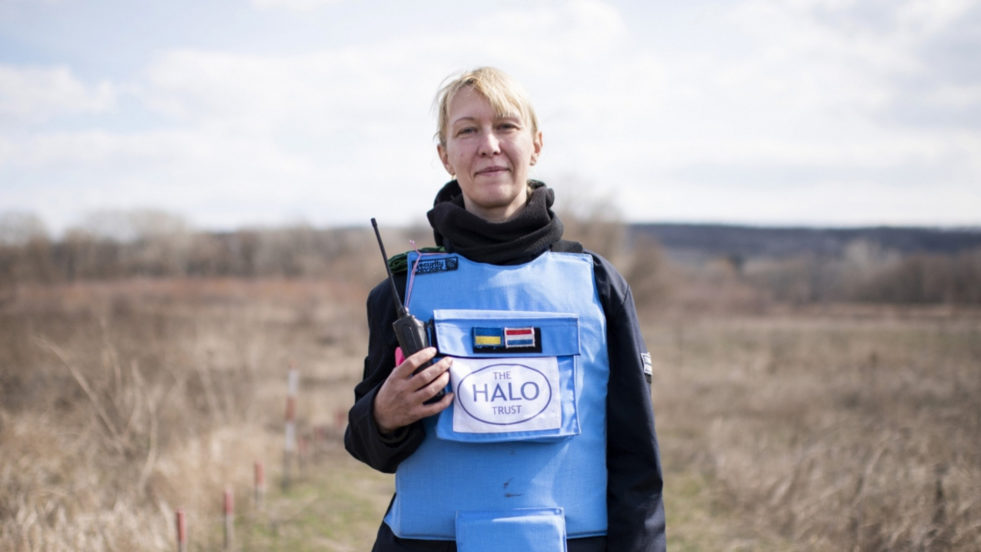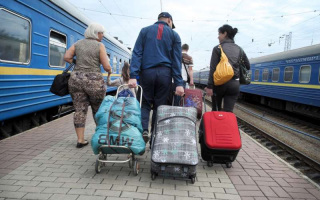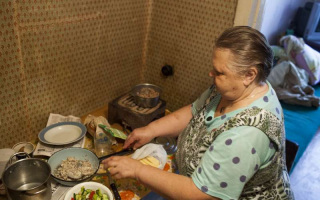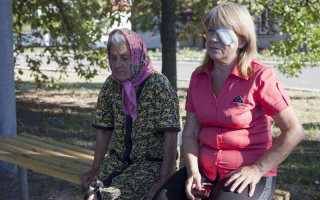
Tetiana Nikiforova, 37, works as a deminer with the HALO Trust in Ukraine. © UNHCR/Marta Iwanek
Ukraine is one of the most mine-affected countries in the world, limiting freedom of movement and posing a serious threat to civilians crossing the contact line.
By Oksana Grytsenko in Toretsk, Ukraine
Sheltering in the basement of his family home in eastern Ukraine, Volodymyr Zayika, 71, was in the dark. Shelling had severed the electricity supply. Venturing out to check on some electrical wires, he felt his foot snag on a wire.
“There was a flash,” he recalls. “Something hissed on my right. Then there was a blast.”
Volodymyr came to on the ground, lying in a cloud of smoke and covered in blood. Later, he learned he had stepped on a trip wire and received wounds to his head, groin and chest, as well his leg and shoulder. Two local men put him on a vegetable cart and pulled him to the nearest checkpoint, where he was driven to hospital in Toretsk.
“The X-ray showed he had 31 wounds,” says his wife Valentyna, a former elementary school teacher near the town of Pivdenne, also 71. Nobody would drive her to the hospital during the fighting, so she packed spare clothes in a plastic bag and walked to see her husband.
After a month at the hospital, the pair discovered they had nowhere to return home to. They say the fighting had forced all the residents of Pivdenne to flee.
“The X-ray showed he had 31 wounds.”
Now displaced, they live in a relative’s flat in Toretsk, just 15 kilometres from the ‘contact line’, which separates Government controlled and non-Government controlled areas. Volodymyr, whose right arm still hurts after the landmine explosion, is busy fixing the walls in the bathroom with wooden planks provided by Proliska, a partner of UNHCR, the UN Refugee Agency, which helps residents living near the contact line.
The family’s experience is all-too common in Ukraine – one of the most mine-affected countries in the world, with over 1,000 mine-related casualties recorded since 2014. In 2018, 43 per cent of civilian casualties were attributed to mine and explosive remnants of war (ERW) incidents. Mine incidents remained the leading cause of child casualties in 2018.
Most recently, in February 2019, two people were killed at the checkpoint in Olenivka when a minivan hit a mine.
Fortunately, help is at hand. Demining experts are risking life and limb to make the area safe for people. Among them is 37-year-old Ukrainian Tetiana Nikoforva. As the sun filters through the trees on recent morning, she takes a drink of warm tea from a flask and admires the first spring flowers.
Then, with a flip of her safety visor, she is back to work, gently probing the soil in front of her for landmines with a team of demining experts from British demining charity the HALO Trust. Her movements are slow and focused. She checks centimetre after centimetre with a plastic stick. The only sounds are the birds singing and the steady rhythm of her own heartbeat.
“I’m happy to be reducing the chance of deaths of both adults and children,” she says. “I feel myself at the right place here. I wanted to be needed.”
Approximately 1.3 million people are displaced in Ukraine, and UNHCR believes it is essential that all children and adults are taught to identify landmines and ERW’s.
The most severely mined areas are those near the contact line, where civilians often risk stepping on landmines in farmland, forests, riverbanks, roadsides, cemeteries and sometimes even next to their homes.
The area where Tetiana sets to work was once a popular picnic spot. Now, after almost five years of conflict in eastern Ukraine, it is a minefield, littered with unexploded ordnance.
The HALO Trust is helping to clear these landmines, as part of a broader humanitarian mine action response, coordinated under the Protection Cluster, led by UNHCR. But mines and other ERW continue to pose a serious threat. There is also an urgent need to provide more support to mine victims and their families, including long-term medical care, rehabilitation and psychosocial support.
On International Mine Awareness Day, UNHCR is calling for increased efforts to address the dangers of landmines in eastern Ukraine. Across the world, refugees and internally displaced people remain particularly vulnerable to the threat of mines in many conflict-affected settings. Whether fleeing from, through or into contaminated areas, these hazards continue to kill, injure and traumatize individuals and communities. Mines are also a critical obstacle to safe and dignified returns, posing tremendous dangers for refugees and displaced people around the world who want to return home and inhibiting wider efforts to rebuild communities after the conflict has ended.
In Ukraine, Tetiana herself knows the true cost of conflict, after her brother-in-law died when a shell exploded next to him.
“I started asking myself why there are so many victims,” she says. “Then I found out how massively our fields are contaminated with landmines and I started thinking of how I could make a difference.”
For a year, Tetiana did not tell her parents that she was searching for landmines. She says her friends were divided about the job. But despite the long, slow and dangerous searches, she is proud to be helping people like Volodymyr feel safe again.
“Years will pass and grandchildren of our grandchildren will come here and walk in this field safely,” she says. “I hope one day Ukraine will be called a country free from landmines.”
Originally published by UNHCR on 2 April 2019





